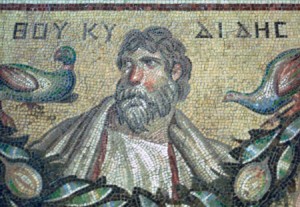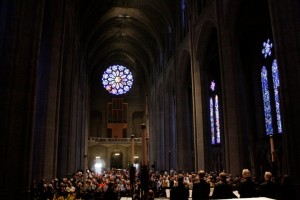Early Modern Whale – Burn as many thousand years in hell, as there be spears of grass in Hyde Park, so saith Christ
Bernard Gordillo – Voices from the 18th Century: Charles Burney on the Making of a Castrato
Magnificat to Host the June ‘History Carnival’
UPDATE May 31 – the June History Carnival is now live – please click here or on the tab above.
On or around June 1, Magnificat will take part in what has become an impressive tradition, when we host the 88th History Carnival. Each month since 2005, links to articles from the well-developed history blogosphere are gathered together on one blog and given some commentary for context.
I discovered the monthly carnival at some point and have found them not only an enjoyable and educational read but a terrific way of ferreting out blogs with obscure and fascinating specializations. They’ve all found a home on my RSS reader and many appear in the sidebar of this blog.
A review of past Carnivals (the archive can be viewed here) demonstrates the exciting work being made available on the internet – at least in general history. In addition to the excellent nominations I have already received, I am planning to feature some blogs that focus on the history of music for this installment of the Carnival.
Nominations for the Carnival can be made by writing to the blog (contact@magnificatbaroque.com) or, more officially, by visiting the History Carnival nomination page.
Monteverdi’s Song of Mary and ‘Re-Animation’
Last weekend I had the privilege of sharing Monteverdi’s Vespro della Beata Vergine of 1610 with an extraordinary assembly of musicians and three engaged and appreciative audiences. I have often said that the most wonderful thing about directing Magnificat is that I get the best spot in the hall to experience fine artists at work and that was definitely the case in these concerts.
When I eventually got home from the Grace Cathedral on Sunday, I opened the laptop to check the Inbox and was greeted with the familiar pop-up window “You are now running on reserve battery.” My initial response was “No kidding!,” a response to which anyone coming off a production like the 1610 Vespers could relate. But it also got me thinking about the ‘rhythm’ of vespers how eloquently Monteverdi embroiders that rhythm and ‘recharges the batteries’ as the vespers moves from one multi-layered text to another. Read more…
The Whole Noyse to Perform with Magnificat
 It is a pleasure to be working together again with The Whole Noyse in Magnificat’s performances of Monteverdi’s 1610 Vespers. In numerous collaborations over the past two decades, I have been consistently impressed with their musicianship and impeccable ensemble playing and Steve, Richard, Sandy and Herb have all become dear friends and trusted musical colleagues. The Whole Noyse will be joined by cornettist Kiri Tollaksen and frequent collaborator trombonist Ernie Rideout in our Vespers performances.
It is a pleasure to be working together again with The Whole Noyse in Magnificat’s performances of Monteverdi’s 1610 Vespers. In numerous collaborations over the past two decades, I have been consistently impressed with their musicianship and impeccable ensemble playing and Steve, Richard, Sandy and Herb have all become dear friends and trusted musical colleagues. The Whole Noyse will be joined by cornettist Kiri Tollaksen and frequent collaborator trombonist Ernie Rideout in our Vespers performances.
The Whole Noyse has collaborated with Magnificat from our very first season in 1992, when they joined for a series of memorable performances of Schütz’ Weihnachtshistorie, co-presented by the San Francisco Early Music Society. In 1994, they joined in our staged production of Cavalieri’s Rappresentatione di Anima e di Corpo, which we subsequently recorded for Koch International. No one who was present will forget the infamous Halloween recording session that stretched into the wee hours of the morning at St. Vincent’s in Marinwood! Later in 1994, we first performed Monteverdi’s Vespers, which were co-presented by SFEMS and the Sonoma Bach Society. We would perform the Vespers again together in 1999. Read more…
The ‘Specialness’ of Monteverdi’s Vespers
This article is adapted from a longer article that appears in the April issue of the San Francisco Early Music Society newsletter, which can be viewed and downloaded in PDF format at the SFEMS website.
 Recently Craig Zeichner, who is writing a piece about “2010 Vespermania,” asked me what made the Monteverdi Vespers so special. There are so many different answers to the question, which in itself is certainly a potent argument for its “specialness.” Several generations of writers have explored many angles in describing this amazing music — certainly more than any other music from the period — and it has become one of the enduring classics of the musical canon.
Recently Craig Zeichner, who is writing a piece about “2010 Vespermania,” asked me what made the Monteverdi Vespers so special. There are so many different answers to the question, which in itself is certainly a potent argument for its “specialness.” Several generations of writers have explored many angles in describing this amazing music — certainly more than any other music from the period — and it has become one of the enduring classics of the musical canon.
Surely one of the most striking aspects of this music is Monteverdi’s astonishing juxtaposition of old and new in a way that perfectly captured the zeitgeist of Italy in 1610. In fact, few works of art are so strongly associated with a specific year. At the same time, the music succeeds in transcending identification with any particular time and place.
But in considering Craig’s question, I found myself asking another: “What was the motivation for this grandiose display of talent?”
The answer may lie in the specific circumstances in which the collection was assembled. As many scholars have demonstrated, the Mass and Vespers collection of 1610 does not present the music performed for any specific event. Indeed, combining the five psalms and five sacri concenti into a single liturgy is problematic. But why a collection of sacred music — a genre almost entirely absent from Monteverdi’s published music in the first 40 years of his life? All indications suggest that the publication was intended to help Monteverdi escape the Mantuan court. Read more…
Re-Discovering Monteverdi’s Vespers of 1610
This article is adapted from a longer article that appears in the April issue of the San Francisco Early Music Society newsletter, which can be viewed and downloaded in PDF format at the SFEMS website.
One of the great joys of Magnificat has been the opportunity of exploring the astounding repertoire of 17th-century music that has been unjustly neglected for centuries. Magnificat’s process of discovery has often resulted in modern “premieres” that are exciting for both the musicians and our audiences. But in the case of Monteverdi’s 1610 Vespers, we are approaching music that is generally familiar to our audience — many of whom have even sung the piece — and each of the musicians involved can list multiple performances of the work on their resumes. Yet turning to Monteverdi’s familiar music together is no less a revelation than any premiere, especially in the company of musical friends that bring such a breadth of experience with them to the performances.
It has been observed that Monteverdi’s astonishing juxtaposition of old and new perfectly captured the zeitgeist of Italy in 1610 and, in fact, few artworks are so strongly associated with a specific year. At the same time, the music succeeds in transcending identification with any particular time and place. It is this sense of timeless beauty that has captured the imagination of generations and made it one of the most beloved works of Western Art. Read more…
Matteo Ricci (1552–1610)
Matteo Ricci was born into a noble Italian family in Macerata, Italy. He studied law in Rome but became more interested in the new science that was sweeping Western Europe. Entering the Society of Jesus in 1571, he continued his studies in philosophy, theology, mathematics, cosmology, and astronomy. Ricci was sent on a mission to Asia and in 1580 was sent by Alessandro Valignani, superior of Jesuit missions in the East Indies, to prepare to enter China.
In the Portuguese colony of Macau Ricci mastered the Chinese language and entered China in 1583 dressed first in the clothing of a Buddhist monk and then later as a Confucian mandarin. He brought with him Western clocks, musical instruments, mathematical and astronomical instruments, and cosmological, geographical, and architectural works with maps and diagrams. These, along with Ricci’s phenomenal memory and mathematical and astronomical skills, attracted an important audience among the Chinese elite. Read more…
Monteverdi’s Unsuccessful ‘Audition’ in Rome
As early as the Fall of 1608 Monteverdi had discussed the possibility of leaving Mantua and his publication of a monumental Mass and Vespers in 1610, with a dedicate to Pope Paul V was clearly an attempt to promote his services. In that year, with his collection in tow, Monteverdi traveled to Rome, where he hoped to achieve two results: an audience with the Pope to enable him to offer his sacred collection in person, and a free place for his son Francesco. (Monteverdi was a widower of over two years at that point.) In a letter from that month he wrote to Cardinal Ferdinando Gonzaga:
“‘in the Roman seminary with a benefice from the church to pay his board and lodging, I being a poor man. But without this favor I could not hope for anything from Rome to help Franceschino, who has already become a seminarian in order to live and die in this calling.”
None of the composer’s plans came to fruition, and the letter, which gives a sense of the his dire financial situation, continues:
“For if Rome, even with Your Most Illustrious Lordship’s favor, were not to help him, he and another brother of his would remain poor, so that they wowukld hardly be able to start the New Year with bread and wine, which I lack. I shall look out for some simple benefice or other that can bring in a stipend sufficient to obtain the satisfaction of this need from His Holiness, if Your Most Illustrious Lordship will be so kind as to try and assist both him and me at the same time (as I hope from your infinite virtue), both with His Holiness and with Monsignor the Datary; otherwise, fearing that I troubled him too much when I was in Rome, I would not dare to ask him again any favor.”
[Translation by Time Carter from Paolo Fabbri’s Monteverdi, Cambridge University Press, 1994, pp 109-110.]
Galileo’s Music
On his remarkable Galileo 1610 website, Mark Thompson writes about the role of music Gilileo’s scientific work:
“Thus the effect of the fifth is to produce a tickling of the eardrum such that its softness is modified with sprightliness, giving at the same moment the impression of gentle kiss and of a bite.”
Music played not only a unique, but an essential role in leading Galileo to his new physics. Because it is an art demanding precise measurement and exact divisions, music reflected the spirit of Galileo’s science.
One of Galileo’s most important discoveries, the law of falling bodies, can actually be traced to his early musical experiments with his father, Vincenzo Galilei, a musicologist and lute virtuoso. Together, they discovered the motions of pendulums while measuring with weights, the tensions of lute strings.
Galileo was an outstanding lutenist himself, whose “charm of style and delicacy of touch” surpassed even that of his father. Playing the lute was a source of great pleasure and a special comfort to him in his final years, when blindness was added to the many other trials of his life.
”Everything Galileo ever did has been challenged,” said the late Stillman Drake, Canadian historian of science and preeminent biographer of Galileo. ”But ultimately it stands up.”
Grandi’s Cantatas – A Link with Improvisational Practice?
The three works in Grandi’s Cantade et Arie a voce sola of 1620 that bear the designation of “cantata” are all constructed using the technique that musicologists now categorize as “strophic bass” cantatas. In its classic form as represented in these pieces, the same bass line is used for each stanza of a strophic poem with varying melodies in the vocal part.
Ostinato bass lines were already common at the beginning of the century, but these new cantatas were distinguished by the greater length of their recurring bass line and their more definite structure. The strophic bass cantata is anticipated in, for example Monteverdi’s Orfeo in variations of the vocal line above a slightly modified bass line within a ritornello structure are found.
Grandi’s innovation can be seen as a logical extension of an improvised practice. It is likely that performers, in interpreting a strophic song would vary the melodic line for each stanza to emphasize certain words or communicate different sentiments. “Arias” setting strophic poetry are found in innumerable collections from the early years of the 17th Century, and in fact the bulk of Grandi’s 1620 collection is devoted to such strophic songs. One has to think only of Monteverdi’s Si dolce e’l tormento – a remarkably simple looking work on the page – and how it can be varied to exceptional effect in performance.
The cantatas in the 1620 collection formalize this practice, though they certainly do not preclude further embellishment and variation by the singer. There are numerous accounts of virtuosi, like Francesca Caccini, who could improvise a musical setting of poem and one can imagine that a strophic bass technique would lend itself to such extemporizing.
Grandi’s cantatas were immensely popular. The newly identified print from 1620, from which the cantatas on Magnificat’s program are drawn was in fact a reprint of an earlier publication and he went on to publish three more collections over the next decade, only one of which survives. Numerous composers imitated the cantatas, including Monteverdi himself.
Even in the 1620s we can observe the characteristic of the later Baroque cantata emerging, as composers begin to modify the bass line and alternating recitative and arioso styles in the vocal lines. Amor, giustitia amor, the one work designated “cantata” in Grandi’s third book of Cantade et Arie, published in 1626, which Magnificat will also be performing, already shows considerable variation in the bass line from stanza to stanza and clearly anticipates the more variegated form of the later cantata. The expansion of the stanzas into distinct sections is paralleled in the development of the trio sonata from a free flowing sectional form to a set of individual movements over the course of the 17th Century.















